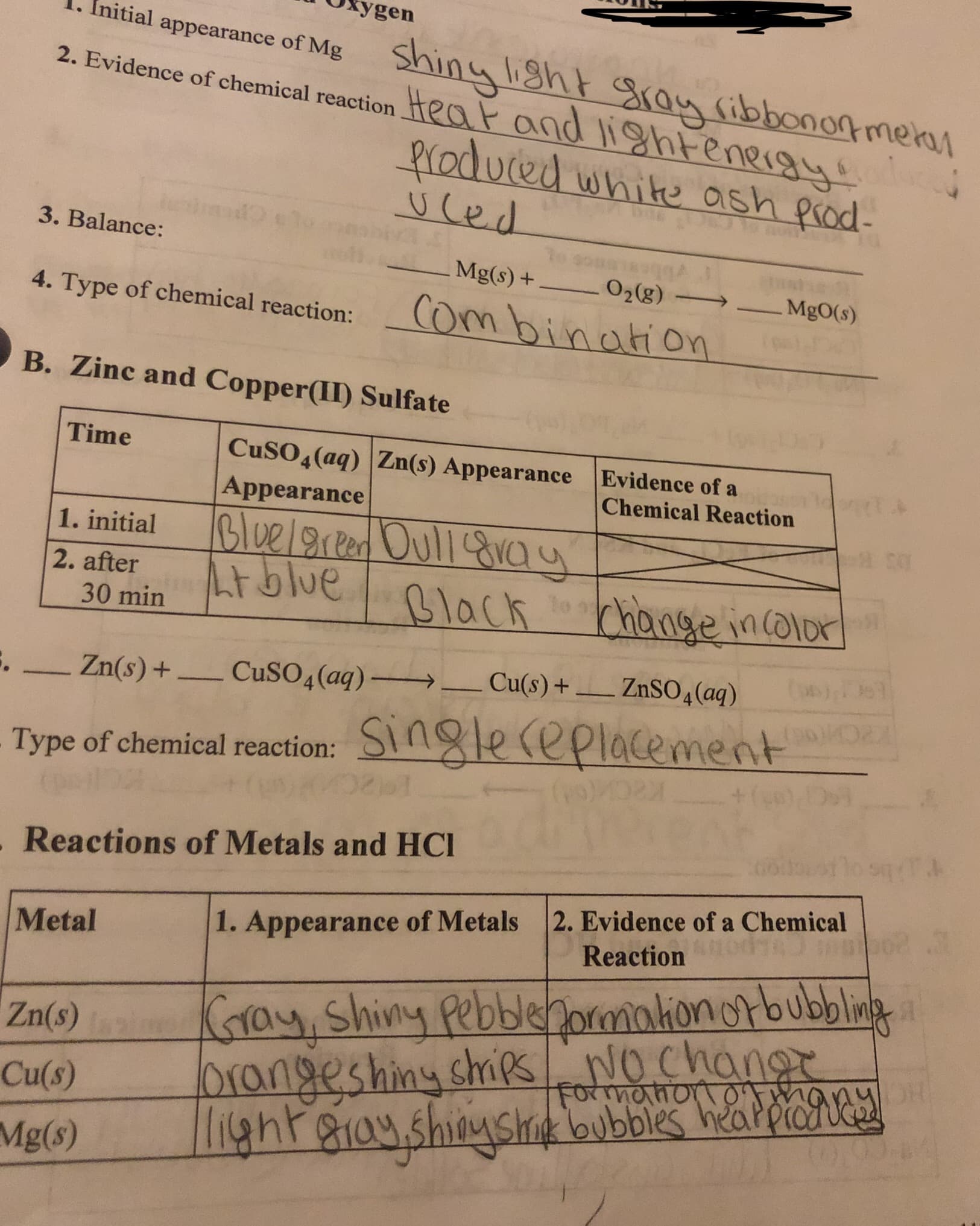ygen nitial appearance of Mg Shiny lisht Sroy ribbonot mekal 2. Evidence of chemical reaction Hea t and lightenergyduc 1. froduced white ash prod- u ced 3. Balance: Mg(s) + 02(g) - MgO(s) 4. Type of chemical reaction: combination B. Zinc and Copper(II) Sulfate Time CUSO4(aq) Zn(s) Appearance Evidence of a Appearance Chemical Reaction Glue/9ren Oull&vy 1. initial 2. after ७ \०ch " Black change incolor 30 min Zn(s)+ CuSO4(aq) Cu(s)+ ZNSO4(aq) Type of chemical reaction: SInglereplacement - Reactions of Metals and HCI 2. Evidence of a Chemical Reaction Metal 1. Appearance of Metals Gray, shiny pebblehormationorbubblina Nochange Zn(s) orangeshinyshrips ॥ht eroडs HO Cu(s) িত Formaiono Mg(s) ight gray.shinysr bubbles hearpicuR 3. Zn(s)+ HCl(aq) ZnCl, (aq) + H2(g) Cu(s)+ HCl(aq) CuCl, (aq)+ H2(g) Mg(s) + HCl(aq) MgCl2(aq) + H2(g) 4. Type of chemical reaction: Zn Cu _NO alparent reaction Mg D. Reactions of Ionic Compounds D1 Reaction of CaCl, and Na3PO4 Reactants 1. Appearance of Solutions 2. Evidence of a Chemical Reaction Clearand (dorless liqued Na,PO4(aq) C\eorand colorlesslitoicd, CaCl2 (aq) Formationo 'awhite sold. 3. CaCl2 (aq)+ Na3PO4 (aq)-→ Ca3 (PO4)2(8)+ NaC(aq) 4. Type of reaction: D2 Reaction of FeCl3 and KSCN 1. Appearance of Solutions 2. Evidence of a Chemical Reaction Reactants orange liquid change in blood KSCN(aq) clear colloless ligudcogrt KSCN(aq) Fe(SCN); (aq)+ FeCl3(aq) 3. FeCl3 (aq) + 4. Type of reaction: E. Sodium Carbonate and HCI 2. Evidence of a Chemical 1. Appearance of Reactants Reactants Reaction Klearicolorless lAuid Foimakon o Na-CO,() ile, crgslalline Solide many bubbis HC1(aq)
ygen nitial appearance of Mg Shiny lisht Sroy ribbonot mekal 2. Evidence of chemical reaction Hea t and lightenergyduc 1. froduced white ash prod- u ced 3. Balance: Mg(s) + 02(g) - MgO(s) 4. Type of chemical reaction: combination B. Zinc and Copper(II) Sulfate Time CUSO4(aq) Zn(s) Appearance Evidence of a Appearance Chemical Reaction Glue/9ren Oull&vy 1. initial 2. after ७ \०ch " Black change incolor 30 min Zn(s)+ CuSO4(aq) Cu(s)+ ZNSO4(aq) Type of chemical reaction: SInglereplacement - Reactions of Metals and HCI 2. Evidence of a Chemical Reaction Metal 1. Appearance of Metals Gray, shiny pebblehormationorbubblina Nochange Zn(s) orangeshinyshrips ॥ht eroडs HO Cu(s) িত Formaiono Mg(s) ight gray.shinysr bubbles hearpicuR 3. Zn(s)+ HCl(aq) ZnCl, (aq) + H2(g) Cu(s)+ HCl(aq) CuCl, (aq)+ H2(g) Mg(s) + HCl(aq) MgCl2(aq) + H2(g) 4. Type of chemical reaction: Zn Cu _NO alparent reaction Mg D. Reactions of Ionic Compounds D1 Reaction of CaCl, and Na3PO4 Reactants 1. Appearance of Solutions 2. Evidence of a Chemical Reaction Clearand (dorless liqued Na,PO4(aq) C\eorand colorlesslitoicd, CaCl2 (aq) Formationo 'awhite sold. 3. CaCl2 (aq)+ Na3PO4 (aq)-→ Ca3 (PO4)2(8)+ NaC(aq) 4. Type of reaction: D2 Reaction of FeCl3 and KSCN 1. Appearance of Solutions 2. Evidence of a Chemical Reaction Reactants orange liquid change in blood KSCN(aq) clear colloless ligudcogrt KSCN(aq) Fe(SCN); (aq)+ FeCl3(aq) 3. FeCl3 (aq) + 4. Type of reaction: E. Sodium Carbonate and HCI 2. Evidence of a Chemical 1. Appearance of Reactants Reactants Reaction Klearicolorless lAuid Foimakon o Na-CO,() ile, crgslalline Solide many bubbis HC1(aq)
Principles of Instrumental Analysis
7th Edition
ISBN:9781305577213
Author:Douglas A. Skoog, F. James Holler, Stanley R. Crouch
Publisher:Douglas A. Skoog, F. James Holler, Stanley R. Crouch
ChapterA1: Evaluation Of Analytical Data
Section: Chapter Questions
Problem A1.7QAP
Related questions
Question

Transcribed Image Text:ygen
nitial appearance of Mg Shiny lisht Sroy ribbonot mekal
2. Evidence of chemical reaction Hea t and lightenergyduc
1.
froduced white ash prod-
u ced
3. Balance:
Mg(s) + 02(g) -
MgO(s)
4. Type of chemical reaction:
combination
B. Zinc and Copper(II) Sulfate
Time
CUSO4(aq) Zn(s) Appearance Evidence of a
Appearance
Chemical Reaction
Glue/9ren Oull&vy
1. initial
2. after
७ \०ch "
Black change incolor
30 min
Zn(s)+
CuSO4(aq)
Cu(s)+
ZNSO4(aq)
Type of chemical reaction: SInglereplacement
- Reactions of Metals and HCI
2. Evidence of a Chemical
Reaction
Metal
1. Appearance of Metals
Gray, shiny pebblehormationorbubblina
Nochange
Zn(s)
orangeshinyshrips
॥ht eroडs
HO
Cu(s)
িত
Formaiono
Mg(s)
ight gray.shinysr bubbles hearpicuR

Transcribed Image Text:3.
Zn(s)+
HCl(aq)
ZnCl, (aq) +
H2(g)
Cu(s)+
HCl(aq)
CuCl, (aq)+
H2(g)
Mg(s) +
HCl(aq)
MgCl2(aq) +
H2(g)
4. Type of chemical reaction:
Zn
Cu _NO alparent reaction
Mg
D. Reactions of Ionic Compounds
D1 Reaction of CaCl, and Na3PO4
Reactants
1. Appearance of
Solutions
2. Evidence of a Chemical
Reaction
Clearand (dorless liqued
Na,PO4(aq) C\eorand colorlesslitoicd,
CaCl2 (aq)
Formationo
'awhite sold.
3.
CaCl2 (aq)+
Na3PO4 (aq)-→
Ca3 (PO4)2(8)+
NaC(aq)
4. Type of reaction:
D2 Reaction of FeCl3 and KSCN
1. Appearance of
Solutions
2. Evidence of a Chemical
Reaction
Reactants
orange liquid change in
blood
KSCN(aq) clear colloless ligudcogrt
KSCN(aq) Fe(SCN); (aq)+
FeCl3(aq)
3.
FeCl3 (aq) +
4. Type of reaction:
E. Sodium Carbonate and HCI
2. Evidence of a Chemical
1. Appearance of
Reactants
Reactants
Reaction
Klearicolorless lAuid Foimakon o
Na-CO,() ile, crgslalline Solide many bubbis
HC1(aq)
Expert Solution
This question has been solved!
Explore an expertly crafted, step-by-step solution for a thorough understanding of key concepts.
This is a popular solution!
Trending now
This is a popular solution!
Step by step
Solved in 4 steps

Recommended textbooks for you

Principles of Instrumental Analysis
Chemistry
ISBN:
9781305577213
Author:
Douglas A. Skoog, F. James Holler, Stanley R. Crouch
Publisher:
Cengage Learning


Principles of Instrumental Analysis
Chemistry
ISBN:
9781305577213
Author:
Douglas A. Skoog, F. James Holler, Stanley R. Crouch
Publisher:
Cengage Learning
